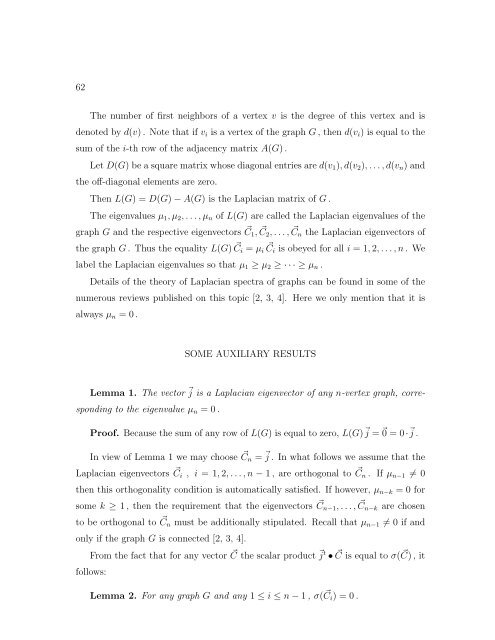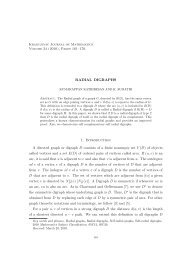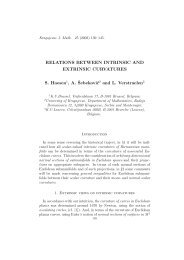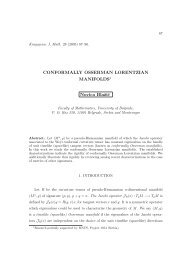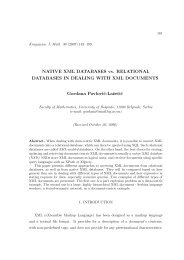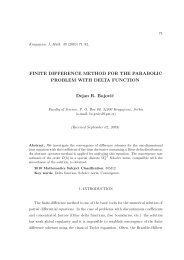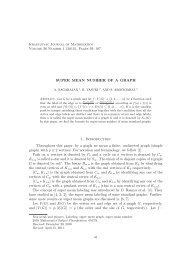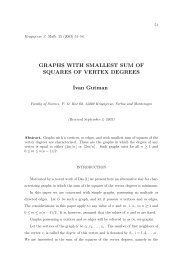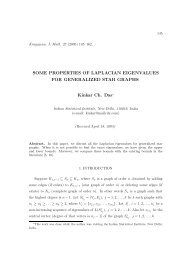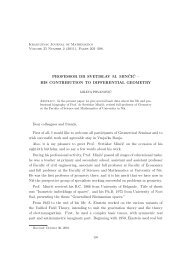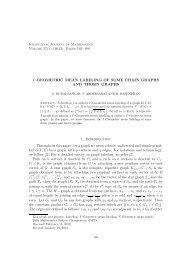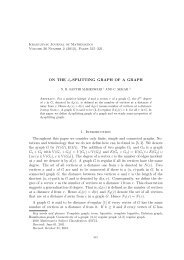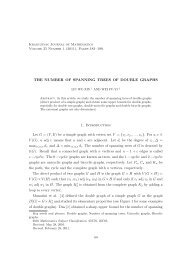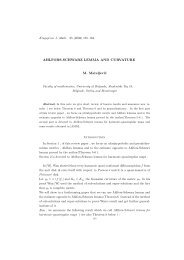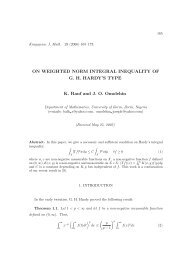The star is the tree with greatest greatest Laplacian eigenvalue
The star is the tree with greatest greatest Laplacian eigenvalue
The star is the tree with greatest greatest Laplacian eigenvalue
Create successful ePaper yourself
Turn your PDF publications into a flip-book with our unique Google optimized e-Paper software.
62<br />
<strong>The</strong> number of first neighbors of a vertex v <strong>is</strong> <strong>the</strong> degree of th<strong>is</strong> vertex and <strong>is</strong><br />
denoted by d(v) . Note that if v i <strong>is</strong> a vertex of <strong>the</strong> graph G , <strong>the</strong>n d(v i ) <strong>is</strong> equal to <strong>the</strong><br />
sum of <strong>the</strong> i-th row of <strong>the</strong> adjacency matrix A(G) .<br />
Let D(G) be a square matrix whose diagonal entries are d(v 1 ), d(v 2 ), . . . , d(v n ) and<br />
<strong>the</strong> off-diagonal elements are zero.<br />
<strong>The</strong>n L(G) = D(G) − A(G) <strong>is</strong> <strong>the</strong> <strong>Laplacian</strong> matrix of G .<br />
<strong>The</strong> <strong>eigenvalue</strong>s µ 1 , µ 2 , . . . , µ n of L(G) are called <strong>the</strong> <strong>Laplacian</strong> <strong>eigenvalue</strong>s of <strong>the</strong><br />
graph G and <strong>the</strong> respective eigenvectors C ⃗ 1 , C ⃗ 2 , . . . , C ⃗ n <strong>the</strong> <strong>Laplacian</strong> eigenvectors of<br />
<strong>the</strong> graph G . Thus <strong>the</strong> equality L(G) C ⃗ i = µ i Ci ⃗ <strong>is</strong> obeyed for all i = 1, 2, . . . , n . We<br />
label <strong>the</strong> <strong>Laplacian</strong> <strong>eigenvalue</strong>s so that µ 1 ≥ µ 2 ≥ · · · ≥ µ n .<br />
Details of <strong>the</strong> <strong>the</strong>ory of <strong>Laplacian</strong> spectra of graphs can be found in some of <strong>the</strong><br />
numerous reviews publ<strong>is</strong>hed on th<strong>is</strong> topic [2, 3, 4]. Here we only mention that it <strong>is</strong><br />
always µ n = 0 .<br />
SOME AUXILIARY RESULTS<br />
Lemma 1. <strong>The</strong> vector ⃗j <strong>is</strong> a <strong>Laplacian</strong> eigenvector of any n-vertex graph, corresponding<br />
to <strong>the</strong> <strong>eigenvalue</strong> µ n = 0 .<br />
Proof. Because <strong>the</strong> sum of any row of L(G) <strong>is</strong> equal to zero, L(G)⃗j = ⃗0 = 0 ·⃗j .<br />
In view of Lemma 1 we may choose C ⃗ n = ⃗j . In what follows we assume that <strong>the</strong><br />
<strong>Laplacian</strong> eigenvectors C ⃗ i , i = 1, 2, . . . , n − 1 , are orthogonal to C ⃗ n . If µ n−1 ≠ 0<br />
<strong>the</strong>n th<strong>is</strong> orthogonality condition <strong>is</strong> automatically sat<strong>is</strong>fied. If however, µ n−k = 0 for<br />
some k ≥ 1 , <strong>the</strong>n <strong>the</strong> requirement that <strong>the</strong> eigenvectors C ⃗ n−1 , . . . , C ⃗ n−k are chosen<br />
to be orthogonal to C ⃗ n must be additionally stipulated. Recall that µ n−1 ≠ 0 if and<br />
only if <strong>the</strong> graph G <strong>is</strong> connected [2, 3, 4].<br />
From <strong>the</strong> fact that for any vector C ⃗ <strong>the</strong> scalar product ⃗j t • C ⃗ <strong>is</strong> equal to σ( C) ⃗ , it<br />
follows:<br />
Lemma 2. For any graph G and any 1 ≤ i ≤ n − 1 , σ( C ⃗ i ) = 0 .


